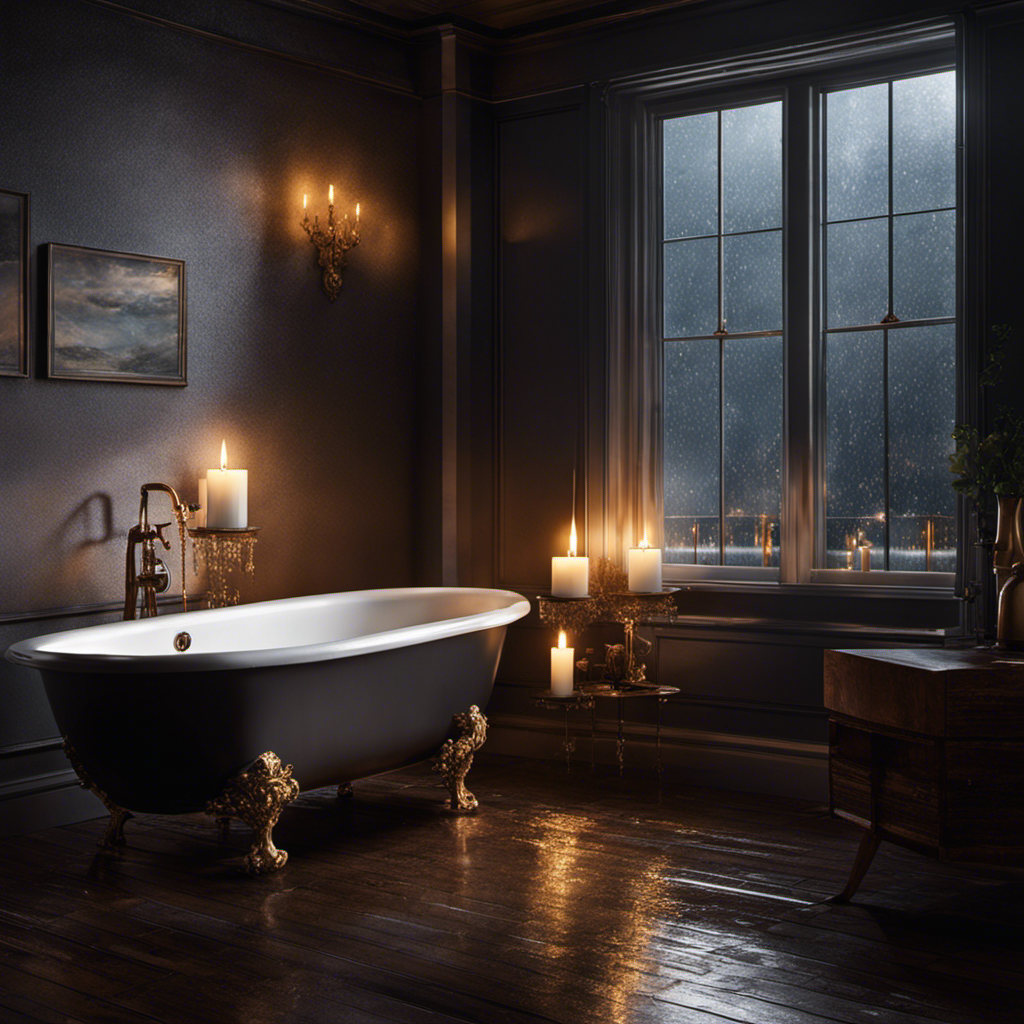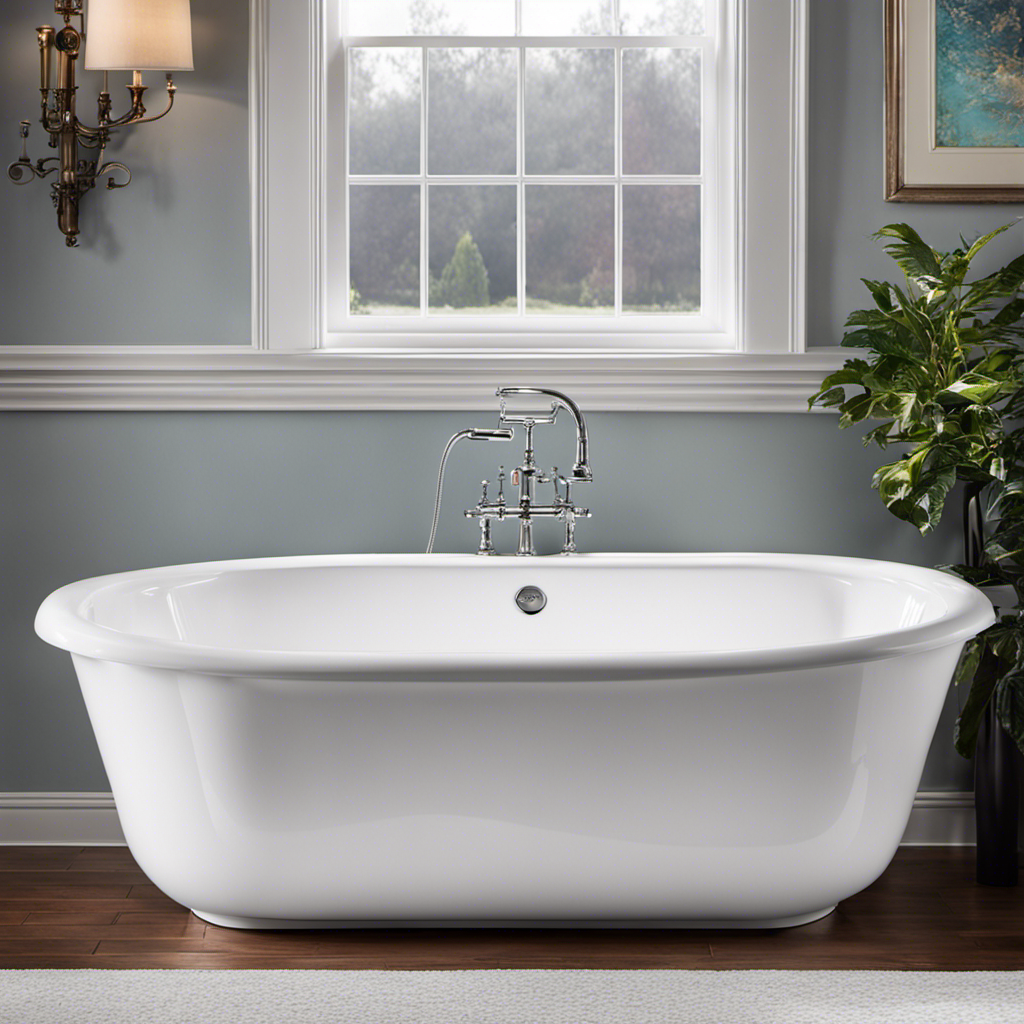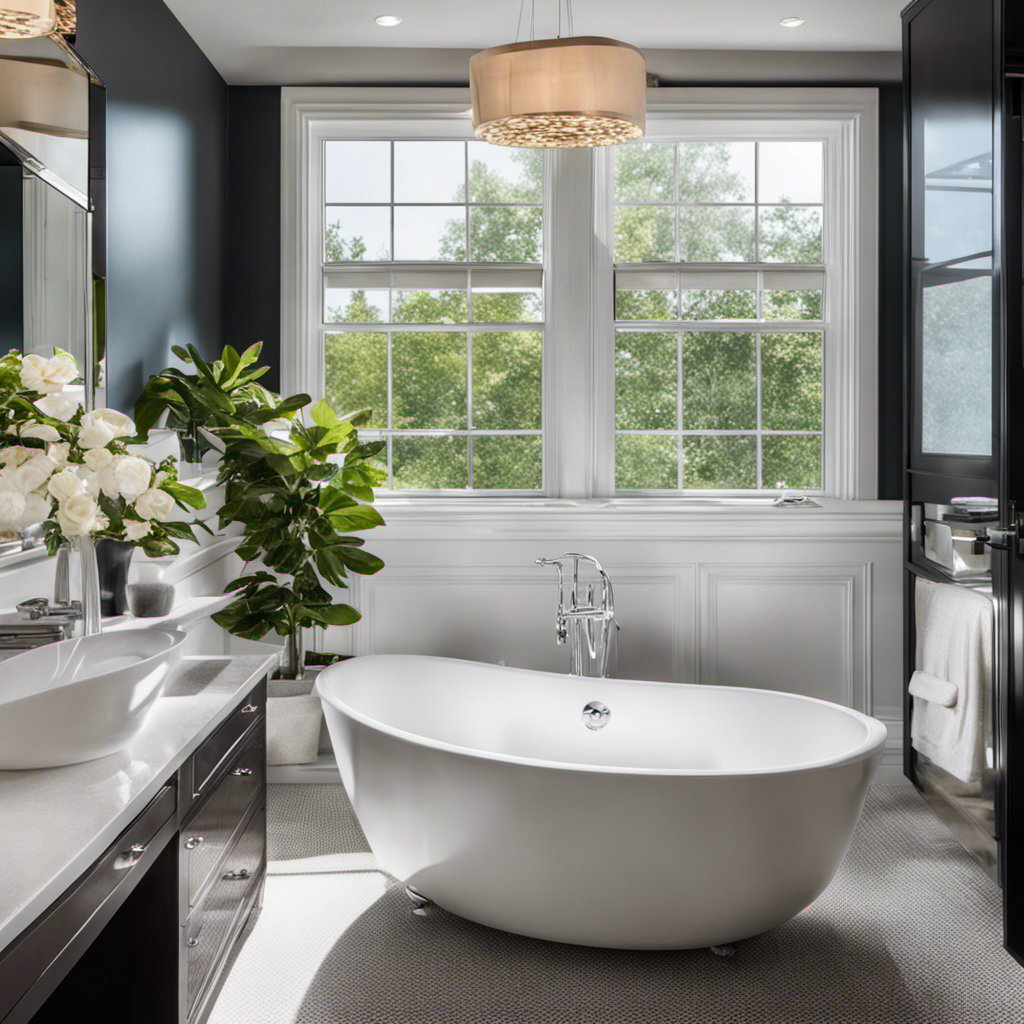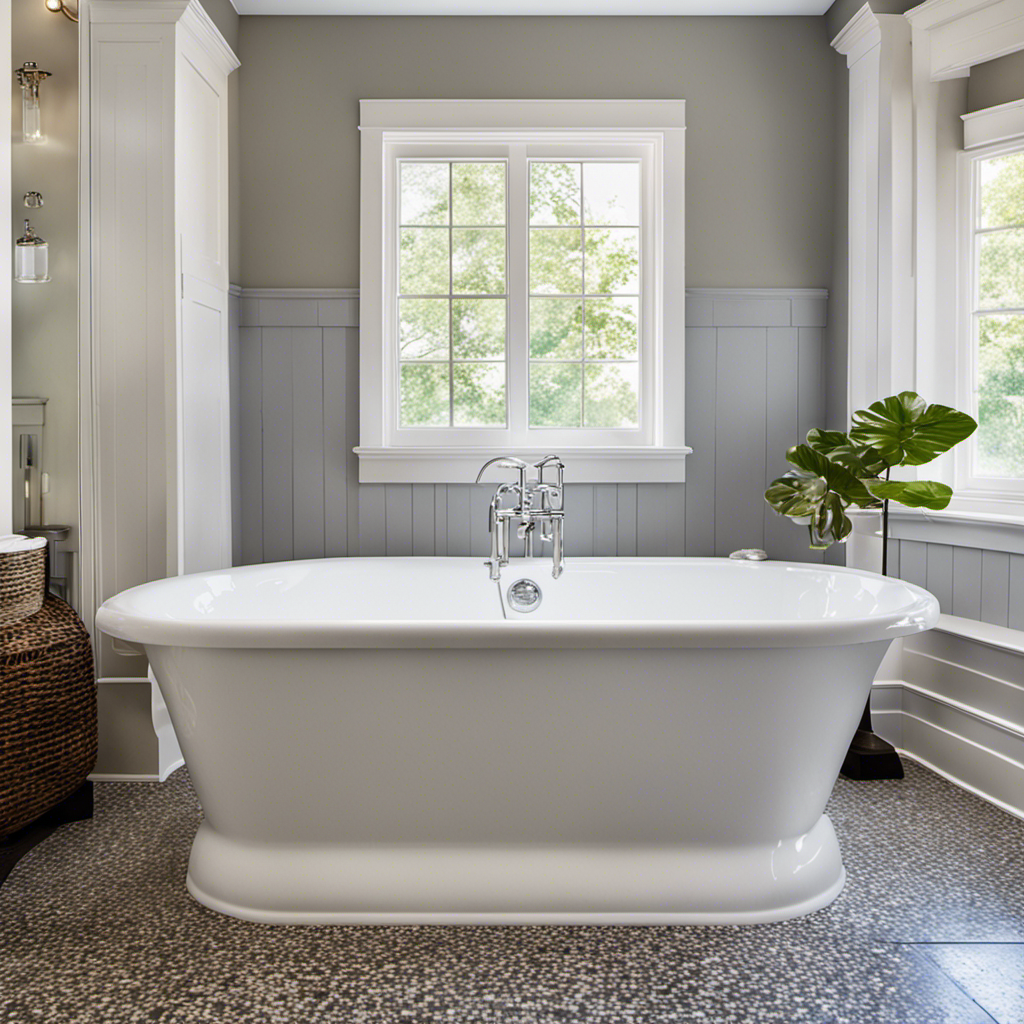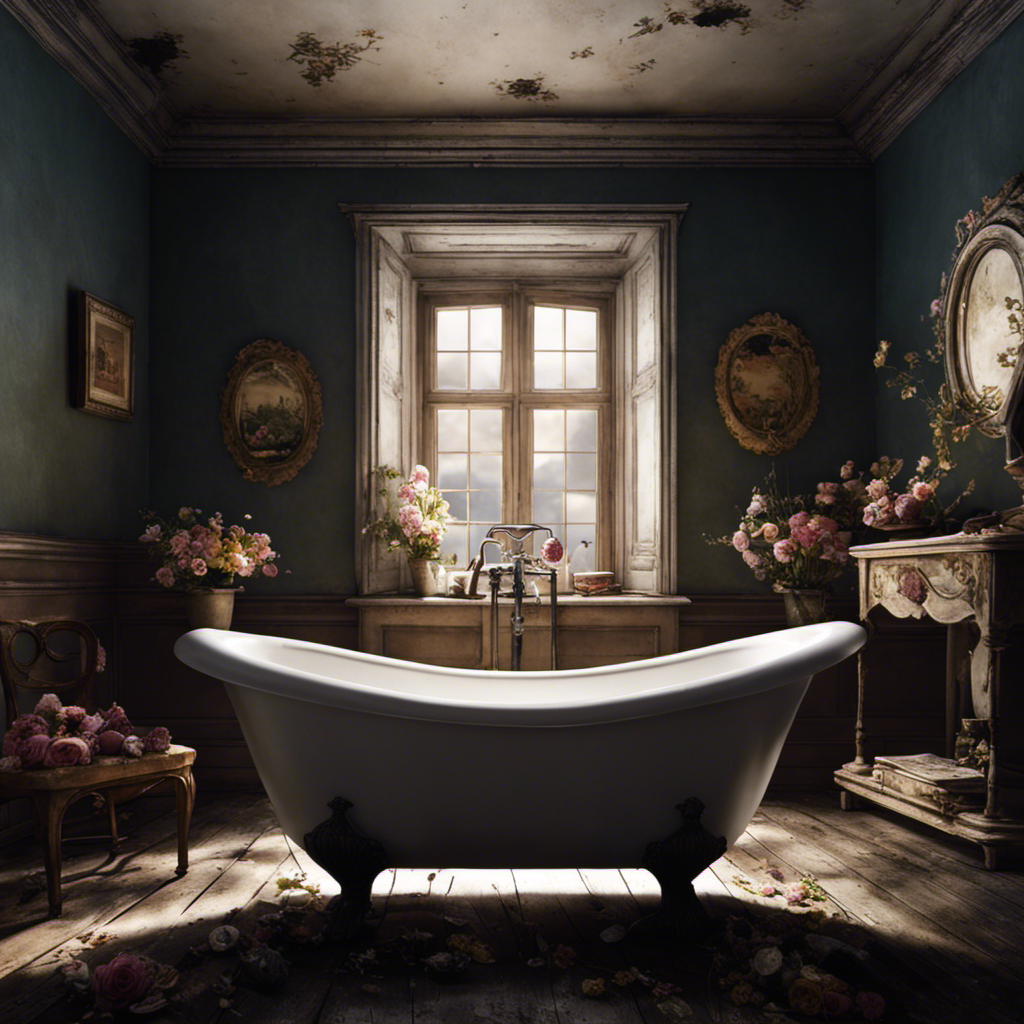I’ve always been curious about the origins of everyday objects, like the bathtub. It’s fascinating to think about how something as simple as a place to bathe has evolved over time.
So, when was the bathtub invented? In this article, we will explore the rich history of the bathtub, from ancient bathing practices to modern innovations. By examining the evidence and delving into historical records, we can uncover the truth behind this essential fixture in our lives.
Key Takeaways
- The bathtub can be traced back to ancient civilizations, such as the Greeks, Romans, Egyptians, and Indians, who had elaborate bathing practices for relaxation, socialization, and purification.
- Bathing rituals varied across different cultures and time periods, with practices like bathing in the Nile River, using natural oils and perfumes, and communal bathing in Japanese onsens.
- The invention of the modern bathtub revolutionized bathing practices, with the development of plumbing systems and shower systems providing easy access to running water and a quicker bathing experience.
- Bathtub materials and designs have evolved over time, with options like porcelain, cast iron, acrylic, freestanding tubs, clawfoot tubs, and corner tubs, along with various accessories to enhance functionality and style.
Early Origins of the Bathtub
The early origins of the bathtub can be traced back to ancient civilizations. Ancient bathing rituals played a significant role in various cultures, and the development of the bathtub was a natural progression.
Evidence suggests that the ancient Greeks and Romans had elaborate bathing practices, with communal bathhouses being common. These bathing rituals held cultural significance, serving as a form of relaxation, socialization, and purification. The Romans, in particular, constructed intricate bathing complexes called thermae, which included large pools and individual tubs.
This cultural importance placed on bathing eventually led to the invention of the bathtub as a personal and private space for individuals to indulge in the cleansing and therapeutic benefits of bathing. The ancient origins of the bathtub paved the way for its continued use and evolution throughout history.
Ancient Bathing Practices
Ancient civilizations practiced bathing in various ways, often incorporating it into their daily routines. These ancient spa rituals were not only a means of hygiene but also had therapeutic benefits. Here are four examples of ancient bathing practices:
-
Ancient Egyptians: Bathing was an essential part of Egyptian life, with public baths being popular. They used oils, perfumes, and scented waters to enhance their bathing experience.
-
Ancient Romans: The Romans had elaborate bathhouses where people would gather to socialize and relax. These bathhouses included hot and cold baths, steam rooms, and massage rooms.
-
Ancient Greeks: The Greeks believed in the healing power of water and used natural springs for their bathing rituals. They also had communal baths called ‘palaestras’ where people engaged in physical exercise.
-
Ancient Indians: Ayurveda, an ancient Indian system of medicine, emphasized the use of bathing as a therapeutic practice. It involved the use of aromatic oils, herbs, and massages to promote physical and mental well-being.
These ancient spa rituals laid the foundation for future bathing practices and innovations. In the subsequent section, we will explore the medieval bathing innovations that further advanced the concept of personal hygiene and relaxation.
Medieval Bathing Innovations
I find it fascinating to explore the historical bathing practices and the advancements in hygiene during the medieval period.
By examining these practices, we can gain insight into how bathing rituals evolved over time.
Additionally, understanding the impact of these bathing innovations can shed light on the overall improvement of personal cleanliness and health during the medieval era.
Historical Bathing Practices
During ancient times, people practiced bathing using various methods. Historical bathing rituals varied across different cultures and time periods. Here are four examples of bathing practices from history:
-
Ancient Egyptians: The Egyptians valued cleanliness and bathing was seen as a ritualistic activity. They bathed in the Nile River and used natural oils and perfumes for aromatic purposes.
-
Ancient Romans: Romans viewed bathing as a social activity and built grand public bathhouses. They indulged in hot and cold water baths, followed by massages and exercise.
-
Medieval Europe: Bathing was not common during this time due to religious beliefs and the fear of waterborne diseases. Instead, people used fragrant herbs and powders to mask body odor.
-
Japanese Onsen: Japan has a long-standing tradition of communal bathing in natural hot springs. These onsens are believed to have therapeutic properties and are considered a way to relax and rejuvenate.
These historical bathing rituals provide insights into the cultural significance of cleanliness and personal hygiene practices in different societies throughout history.
Medieval Hygiene Advancements
To improve your personal hygiene during the medieval period, you can explore alternative methods such as fragrant herbs and powders to combat body odor. Hygiene practices during this time were influenced by cultural significance and limited access to clean water. People used various substances to mask unpleasant smells, including lavender, rosemary, and sandalwood. These fragrant herbs were often carried in small sachets or applied directly to the body.
Additionally, powders made from ingredients like ground herbs and flowers were used to absorb sweat and reduce odor. While these methods may have provided temporary relief, they were not as effective as regular bathing. Despite the limitations, these hygiene advancements allowed individuals to maintain some level of cleanliness and mitigate the discomfort associated with poor hygiene practices.
Transitioning into the subsequent section about the impact of bathing innovations, let’s explore how bathing habits evolved over time.
Impact of Bathing Innovations
If you want to learn about the impact of bathing innovations, you’ll discover how different methods were developed to improve personal hygiene. Technological advancements in bathing equipment have played a significant role in enhancing cleanliness and comfort throughout history.
Here are four key ways in which these innovations have made an impact:
-
Invention of the modern bathtub: The introduction of the bathtub revolutionized bathing practices, allowing individuals to immerse themselves in water for a thorough cleanse.
-
Development of plumbing systems: The implementation of plumbing systems enabled the easy access to running water, making bathing more convenient and efficient.
-
Introduction of shower systems: Showers provided a quicker and more invigorating bathing experience, leading to increased hygiene and time-saving benefits.
-
Evolution of bathing rituals: Bathing has always held cultural and social significance, with rituals varying across different societies. Technological advancements have influenced the development of these rituals, shaping how people perceive and experience cleanliness.
Through these advancements, bathing innovations have transformed personal hygiene practices, improving cleanliness, comfort, and overall well-being.
Renaissance Era Bathtubs
When exploring the topic of Renaissance Era bathtubs, it is important to examine the materials used in their construction, the designs that were popular during this time, and the hygiene practices associated with these bathtubs.
Historically, bathtubs were typically made of materials such as copper, tin, or even wood, reflecting the available resources and craftsmanship of the time.
As for designs, freestanding tubs with ornate legs and decorative embellishments were highly favored, showcasing the artistic sensibilities of the Renaissance period.
Additionally, hygiene practices varied, but it is evident that bathing was considered a luxurious and indulgent activity, often accompanied by scented oils, herbs, and even music to enhance the overall experience.
Bathtub Materials Used
You can choose from a variety of materials like porcelain, acrylic, or cast iron for your bathtub. When it comes to bathtub construction, selecting the right material is crucial.
Here are four key factors to consider when choosing a bathtub material:
-
Durability: Porcelain and cast iron are known for their durability, making them popular choices for bathtubs. They can withstand heavy use and are resistant to scratches and stains.
-
Heat retention: Cast iron is known for its excellent heat retention, allowing you to enjoy longer and more relaxing baths. Acrylic bathtubs also have good heat retention properties.
-
Weight: Cast iron bathtubs are heavy and may require additional structural support. Acrylic bathtubs, on the other hand, are lightweight and easier to install.
-
Maintenance: Porcelain and acrylic bathtubs are easy to clean and maintain. Cast iron bathtubs may require periodic re-enameling to maintain their appearance.
Considering these factors will help you choose the right material for your bathtub, ensuring a long-lasting and enjoyable bathing experience.
Bathtub Designs Popular
To add a touch of elegance to your bathroom, consider popular bathtub designs such as freestanding, clawfoot, or corner tubs. These bathtub shapes not only provide functionality but also enhance the aesthetic appeal of your space.
Freestanding tubs, for instance, create a luxurious and contemporary look, while clawfoot tubs offer a classic and vintage charm. Corner tubs, on the other hand, are perfect for optimizing space in smaller bathrooms.
To complement your chosen bathtub design, there are various accessories available in the market. From shower curtains and bath mats to bath caddies and towel racks, these accessories can further enhance the functionality and style of your bathtub.
Now that we have explored popular bathtub designs and accessories, let’s dive into the next section about bathtub hygiene practices.
Bathtub Hygiene Practices?
In my research on bathtub designs, I’ve also come across the importance of maintaining proper hygiene in bathtubs. It’s not enough to just have a beautiful and functional bathtub; regular maintenance is crucial for keeping it clean and germ-free. Here are some effective bathtub cleaning techniques that I’ve found:
-
Scrubbing with a non-abrasive cleaner: Use a mild cleaner and a soft brush or sponge to scrub the bathtub surface.
-
Removing soap scum: A mixture of vinegar and water can be used to effectively remove soap scum buildup.
-
Preventing mold and mildew: Regularly disinfecting the bathtub with a bleach solution can help prevent the growth of mold and mildew.
-
Unclogging drains: Using a drain snake or a mixture of baking soda and vinegar can help clear any clogs in the bathtub drain.
Regular bathtub maintenance offers several benefits:
- Preventing the spread of germs and bacteria.
- Extending the lifespan of the bathtub.
- Enhancing the overall appearance of the bathroom.
- Ensuring a safe and clean bathing experience for you and your family.
18th and 19th Century Bathtubs
During the 18th and 19th centuries, bathtubs were typically made of wood or copper. In the 19th century, there were significant advancements in bathtub designs and manufacturing techniques. One notable design was the slipper bathtub, which had a raised end for added comfort. Another popular design was the clawfoot bathtub, which featured decorative feet made of cast iron.
Technological advancements in bathtub manufacturing during this time included the use of seamless sheet copper and the introduction of enamel coatings. These advancements not only improved the durability and aesthetics of bathtubs but also made them more accessible to a wider range of people.
As we move into the next section, we will explore the modern innovations in bathtub design and technology.
Modern Bathtub Innovations
Take a moment to imagine the luxurious experience of soaking in a state-of-the-art bathtub with built-in massage jets and chromotherapy lighting.
Modern bathtub technology has come a long way, offering a range of advancements that enhance the bathing experience. Here are four smart bathtub advancements that showcase the innovation in this field:
-
Hydrotherapy: Many modern bathtubs now come equipped with massage jets that provide a therapeutic water massage. These jets target specific areas of the body, promoting relaxation and relieving muscle tension.
-
Chromotherapy: Chromotherapy lighting systems have gained popularity in modern bathtubs. These LED lights emit different colors that are believed to have various therapeutic effects on the mind and body.
-
Temperature control: Smart bathtubs now allow users to control the temperature of the water with precision, ensuring a comfortable and relaxing bathing experience.
-
Smart features: Some modern bathtubs are equipped with smart features like built-in speakers, Bluetooth connectivity, and touchscreen control panels, allowing users to personalize their bathing experience further.
With these advancements, modern bathtubs offer an unparalleled level of comfort and relaxation, transforming the bathing experience into a spa-like indulgence.
Future Trends in Bathtub Design
Imagine upgrading your bathroom with cutting-edge bathtub designs that incorporate innovative materials and sleek aesthetics.
The future of bathtub design is set to revolutionize the way we experience relaxation and comfort in our homes.
One of the most exciting trends in bathtub design is the integration of smart technology. Imagine being able to control the temperature, lighting, and even play your favorite music while enjoying a luxurious soak.
Additionally, eco-friendly materials are becoming increasingly popular in bathtub design. Manufacturers are now using sustainable materials such as bamboo, recycled glass, and even reclaimed wood to create beautiful and environmentally friendly bathtubs.
These advancements in design not only enhance the functionality and aesthetics of the bathtub but also contribute to a more sustainable and eco-conscious lifestyle.
Conclusion
In conclusion, the history of the bathtub is a fascinating journey through time. From the ancient bathing practices to the innovative designs of the Renaissance era, and the modern bathtub innovations of the 18th and 19th centuries, we can see how this essential fixture has evolved over the centuries.
Looking ahead, the future trends in bathtub design promise even more luxurious and technologically advanced bathing experiences. The bathtub, a timeless treasure, continues to bring relaxation and rejuvenation to millions around the world.

